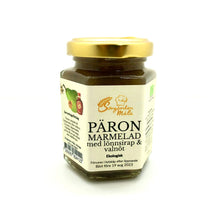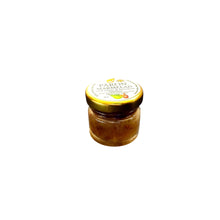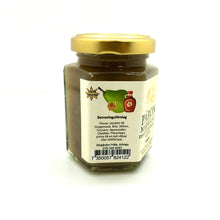
Pears are wonderful. This pear marmalade with maple syrup and walnuts is a perfect combination, the mix of flavors is amazing. Juicy, fragrant pears are perfectly matched with smooth maple syrup and crunchy walnuts in this sweet, well-balanced marmalade. The maple syrup adds delicate caramel tones to this lovely pear marmalade. It tastes fresh and sweet, and the texture is better than any pear marmalade I've made.
Use your imagination and transport yourself to a warm May day when the sun is shining and you're sweating for the first time of the year. A superb sun lounger partner, a magnificent cooking friend and a perfect complement to many of the year's meals.
Perfect for cheese. This pear marmalade elevates your cheese platter from good to divine. Try it with a creamy brie, a simple dish that everyone will love. Wonderful for cakes and muffins, for fluffy pancakes and waffles. It's really good when you spread it on a warm croissant. Holy decadence, Batman. Fantastic as a flavor enhancer to a bowl of vanilla ice cream or yogurt.
Goes well with Brie, Stilton, Gruyere, Appenzeller, Cheddar, Manchego, croissant, ice cream, yogurt
Pear (Pyrus communis) is a species in the pear genus, which grows in temperate climates. Pears are grown for the sake of the fruit, and are almost as hardy as apples
The pear has probably been cultivated as long as the apple tree and existed in Greece as early as 1,000 years BC. In Sweden, pear seeds have been found in grave finds from the Neolithic and cultivation has been known since the Middle Ages. During the Middle Ages, pears were grown in Sweden, and in the 18th century there were many varieties, e.g. bergamot and August pear. The gray pear with its thick, rough skin and sweet, juicy flesh is also old, as is the now rare pear, which Per Brahe is said to have introduced from Germany.[1]
Pears are grown both commercially and privately for the sake of the fruits, which are mostly eaten fresh, but which can also be pickled or preserved. The wood used to be popular and was used for finer carpentry. Several named varieties of pear can be grown in our country, but most are hardy only in the southernmost regions and cultivation is therefore quite limited. Some more famous varieties are 'Gråperon', 'Esperens herreperon', 'Greve Moltke', 'Conference', 'Clara Frijs', Pear 'Herzogin Elsa', 'Anjou' and 'Sommarbergamott'.
Walnuts . This earthy, less oily nut is great with aged cheddar. It is also a perfect match for sheep, goat or mixed milk cheeses. And if you like things a little sharp, walnuts are incredible with blue cheese — especially when covered in honey. We cover them with lovely pear marmalade instead, which gives a divine taste experience.
Maple syrup. Maple syrup was first made and used by the indigenous people of North America. Maple syrup is a syrup usually made from the xylem sap of sugar maple, red maple, or black maple trees, although it can also be made from other maple species. In cold climates, these trees store starch in their trunks and roots before winter; the starch is then converted to sugar that rises in the juice during late winter and early spring. Maple trees are tapped by drilling holes in their trunks and collecting the sap, which is processed by heating to evaporate much of the water, leaving the concentrated syrup.
Ingredients: Pear*, maple syrup*, raw cane sugar*, walnut*, lemon*, pectin (*Organic ingredients)
Fruit amount 64 g per 100g
Nutrition declaration 100g: Energy 832 kJ/197 kcal; Fat 4.9 g (saturated fat 0.5 g); Carbohydrates 37 g (of which sugars 35 g); Protein 1.3 g; Salt 0.03 g















